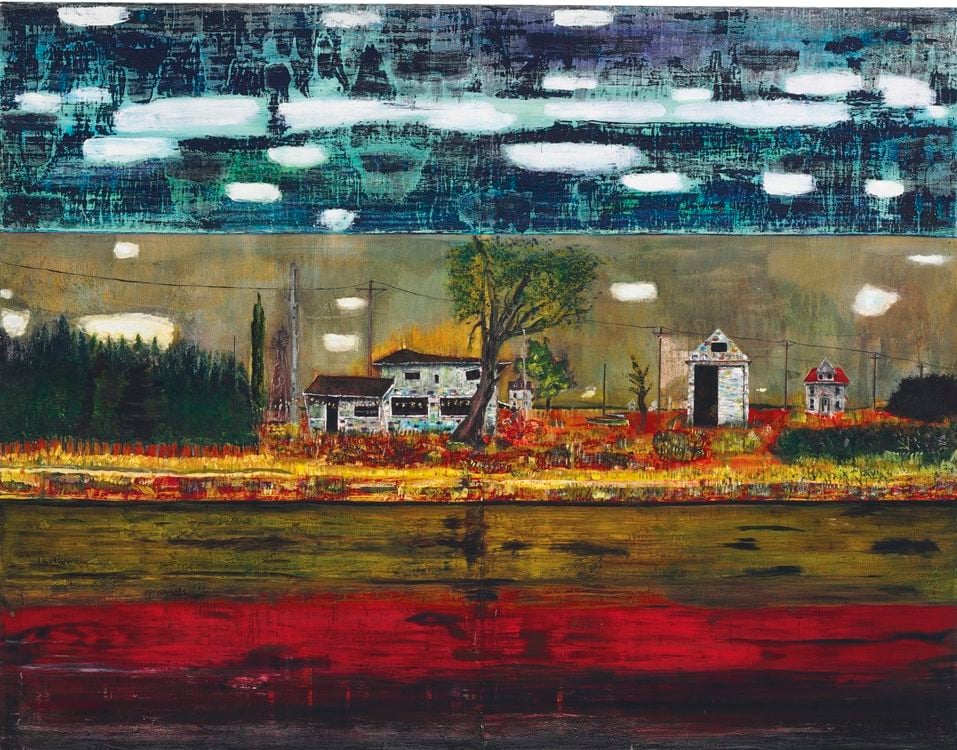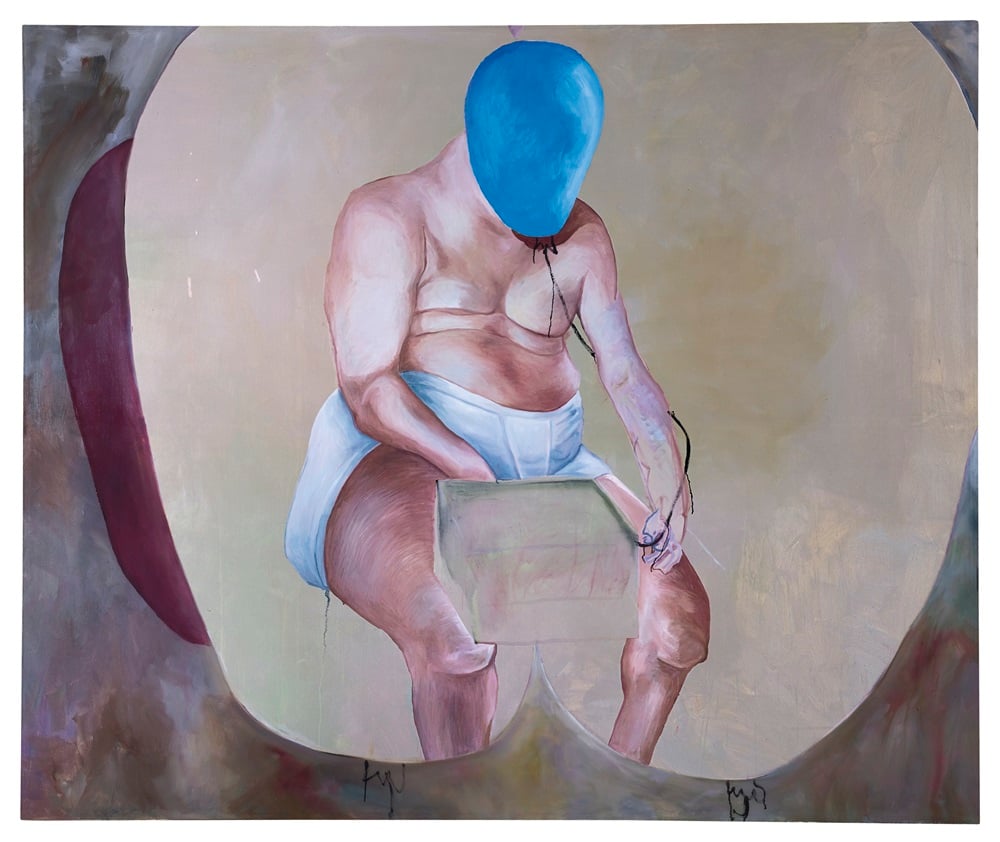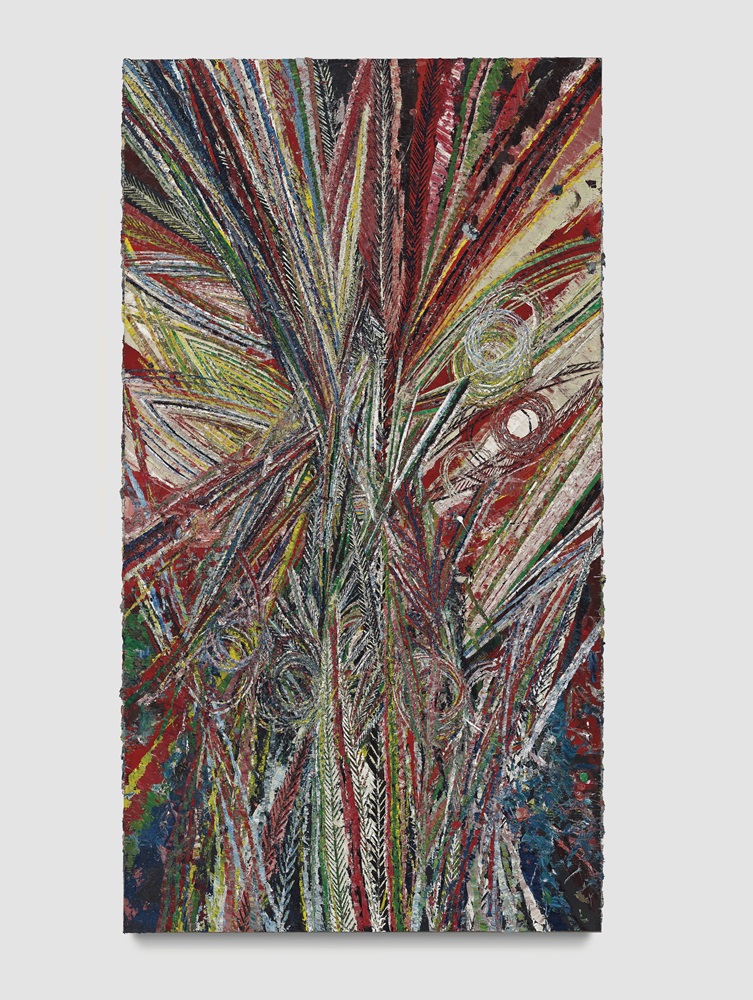Analysis
Christie’s New Contemporary Sale a $135 Million Thumping Success
Loïc Gouzer tested the market for edgy "gritty" contemporary art and triumphed.

Loïc Gouzer tested the market for edgy "gritty" contemporary art and triumphed.

Eileen Kinsella

Christie’s kicked off the busy contemporary auction week tonight with a special tightly focused new sale added to its lineup. Curated by senior specialist Loïc Gouzer and cheekily titled “If I Live I’ll See You Tuesday”—titled after the Richard Prince Joke painting If I Die (1990)—the sale reached $134.6 million, gliding nicely above the estimate of $93.5–126.8 million. Of the 35 lots on offer, all but one, a Cindy Sherman print with a relatively modest $600,000–$800,000 estimate, found buyers. By value, the sale realized 99.5 percent.
The star lot was an untitled portrait by the late German artist Martin Kippenberger, who was famous for his darkly witty works. This 1988 self-portrait was no exception. Christie’s described it as “a paunchy and pugnacious antithesis of the revered genre of self-portraiture.” It had a price tag of $9–12 million and sold for $18.6 million. It far surpassed Kippenberger’s previous record of $6.4 million set for a 1981 untitled acrylic on canvas that also toyed with notions of authorship and self-portraiture. That painting, which sold at Sotheby’s New York this past November, had an estimate of $6–8 million.
The Kippenberger incited a dramatic two-way phone bidding war via Christie’s specialists. Robert Manley went head to head with Xin Li, the New York—based deputy chairman for Christie’s Asia. She was thought to be bidding for an Asian buyer. Xin’s bidder was tenacious, driving the price higher in an effort to shake off Manley’s buyer—sometimes in $1 million increments instead of the standard $250,000 or $500,000 bid usually seen at this price level. At $12.5 million, Xin’s buyer leapt to $13.5 million.
The battle was tense but entertaining, frequently sparking laughter as Manley’s bidder stubbornly adhered to lower $100,000 increments after each big leap. For instance after Xin’s bidder went to $15 million from $13.75 million, and then up to $16 million, Manley’s bidder went to $16.1 million in a final effort to wear the opponent out. It didn’t work; Xin’s bidder went straight to a final bid of a $16.5 million hammer ($18.6 with the premium), and the contest ended there. Auctioneer Jussi Pylkkanen playfully encouraged the rivalry while keeping the action brisk and lively throughout the course of the relatively short sale.
The second-highest lot was an oil on canvas by much sought-after Scottish painter Peter Doig. Christie’s was clearly testing the upper limit of his market with its asking price of $9.5 million to $11.5 million for Road House, a 1991 oil on canvas showing a colorful but sinister landscape, a key work from his early practice. It sold for $11.9 million, setting a new record for the artist.
Doig’s prized paintings were at the forefront of the market peak back in 2007, most notably when a bidding war, reportedly between two Russian oligarchs, broke out at Sotheby’s London for White Canoe (circa 1990). That painting soared to $11.2 million (£5.7 million) on an estimate of $1.6–$2.3 million (£800,000–£1.2 million). But that level has been passed twice since then, most recently with Jetty (1994), which sold for $11.3 million (£7.3 million) million Christie’s London last June on an estimate of $6.6-9.2 million (£4–£6 million).

Martin Kippenberger Untitled (1988) sold for $18.6 million.
Estimate: $9–$12 mllion. Photo: Courtesy Christie’s.
The auction was something of a barometer for works by Richard Prince, offering five in all that span the range of his output. The works had a combined low/high estimate of $17.5 million–22.5 million. All were sold for a total of $21.7 million with premium. The most expensive, Nurse of Greenmeadow (2002), sold for $8.6 million on an estimate of $7–9 million, a hair above the previous Nurse painting record of $8.5 million set at Sotheby’s London in 2008. Meanwhile, the painting that inspired the title of the sale, If I Die (1990), sold for $4.6 million on an estimate of $3.5–4.5 million. This marks a new record for a Joke painting; the previous high price was $3.2 million set at Sotheby’s New York in 2010 for White Woman (1990), on a $2.5–3.5 million estimate.
Many top-flight dealers and collectors were in attendance and bidding actively, including Larry Gagosian, David Zwirner, the Nahmad family of art dealers, and Los Angeles–based collector and philanthropist Eli Broad. Was Sotheby’s newest board member Dan Loeb checking out the competition? We spotted him in Christie’s sale room shortly before the auction began, including what looked like a friendly exchange of banter with CEO Steven Murphy.
A bronze sculpture by Jeff Koons, Aqualung (1985), sold for $11.6 million on an estimate of $9–12 million. Gagosian was an underbidder but dropped out around $10 million. The sculpture sold to the Nahmad family. And Warhol’s ominous 1965 silkscreen Little Electric Chair, sold for a premium-inclusive price of $10.5 million on an estimate of $7.5–9.5 million. It was hammered down at $9.2 million to Xin, the specialist who won the Kippenberger for a client several lots earlier, though it was not immediately clear if she was bidding for the same buyer this time.

Mark Grotjahn, Untitled (In and Out of the Darkness Face 43.01) (2011) sold for $6 million.
(Estimate: $3.5 to $4.5 million) Photo: Courtesy Christie’s
Mark Grotjahn‘s Untitled (In and Out of the Darkness Face 43.01) (2011), sold for $6 million on an estimate of $3.5–4.5 million. The current auction record for the artist is $6.5 million, set at Christie’s “11th Hour” charity auction last May, for Untitled (Standard Lotus No. II, Bird of Paradise, Tiger Mouth Face 44.01) (2012) on a $1.52.5 million estimate.
Prior to the event, the sale drew equal measures of hype and criticism. Jerry Saltz called the sale “a bullshit ploy to massage client egos and reel in rubes. And Gallerist just mocked the whole thing, albeit cleverly. But whatever observers thought or said, this was an undeniably high-wattage assembly of some of the most sought-after artworks and names in the contemporary realm today.
Larry Gagosian bid on and won the opening lot, Cady Noland‘s Percussion and Cartridge Revolvers (1984), a work composed of “book cover, wood, police equipment, hooks, rings, nylon strap, leather, and whistle.” Gagosian paid $509,000 with premium on an estimate of $80,000–120,000. He also scored Mike Kelley‘s stuffed animal piece Two Frogs–Two Cats (1990) for $401,000. (the estimate was $250,000–350,000).
David Zwirner was an underbidder on Koons’s Two Ball Total Equilibrium Tank (Spalding Dr. J Silver Series) (1985). He dropped out when the bid hit $6.2 million. It sold for a final price with premium of $6.9 million (the estimate: $4–6 million). He did, however, get Michael Riedel’s silkscreen inks on linen Untitled (td bgcolor) (2012) for $305,000 on an estimate of $80,000–120,000.
Broad’s adviser, stting next to him in the sale room bought Damien Hirst‘s all-black painting Fear (2002), with flies and resin on canvas, for $905,000, well above the $450,000–$650,000 estimate, and John Baldessari‘s Grimm’s Fairy Tales: The Frog King (1982)—one color photograph, one text panel—for $485,000, just inside the estimate of $400,000–600,000.